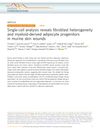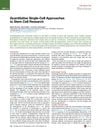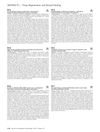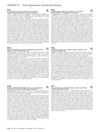Search
forLearn
5 / 8 resultslearn Osteopontin
signaling protein that, when suppressed, may grow hair by reducing inflammation and stem cell loss
learn Epidermal Growth Factor
learn Follistatin
glycoprotein that inhibits TGF-β and promotes hair growth by antagonizing activin
learn Thymosin Beta 4
Research
5 / 1000+ resultsresearch Single-Cell Analysis Identifies Heterogeneity of Fibroblasts and Myeloid-Derived Adipocytes in Regenerating Mouse Skin Wounds
Fibroblasts and myeloid cells in mouse skin wounds are diverse and can change into different cell types during healing.

research Single-Cell Analysis Reveals Fibroblast Heterogeneity and Myeloid-Derived Adipocyte Progenitors in Murine Skin Wounds
The research found that different types of fibroblasts are involved in wound healing and that some blood cells can turn into fat cells during this process.

research Quantitative Single-Cell Approaches to Stem Cell Research
New single-cell analysis techniques are improving our understanding of stem cells and could help in treating diseases.

research Dipeptidyl-Peptidase 4 (DPP4)-Positive Fibroblasts Are Responsible for Secretion of Pro-Fibrotic Matrix Proteins in Human Skin
DPP4-positive fibroblasts play a major role in producing proteins that lead to skin fibrosis.

research The ATP-Dependent Chromatin Remodeler BRG1 Controls Epidermal Keratinocyte Migration During Human Cutaneous Wound Healing
BRG1 is essential for skin cells to move and heal wounds properly.
Community Join
5 / 1000+ results
community Compressed part of research of theory of androgenic/anabolitic balance. AGA h-responders analytic. Theory of physio-metabolitic method of anti AGA treatment
The treatment for androgenetic alopecia involves using finasteride and minoxidil with intense exercise and cold exposure to boost metabolism and reduce androgenic effects, potentially leading to hair regrowth. This approach may activate biological pathways for improved hair and overall health.
community Verteporfin and Microneedling
Clinical studies by Dr. Barghouthi and Dr. Bloxham indicate that Verteporfin, when used with FUE and FUT hair transplantation methods, shows promise in hair follicle regeneration and minimal scarring due to its ability to inhibit Yes-associated protein (YAP). Microneedling at depths of 3-3.5mm, combined with Verteporfin, could potentially reactivate dormant follicles, although the optimal dosage and application method are still under investigation. Concerns remain about the DHT sensitivity of regenerated follicles, highlighting the need for further research to optimize trauma levels and Verteporfin concentrations to achieve effective and scar-free hair regeneration.
community Hair Multiplication Projects in China - Promising clinical trial results on Mice
A breakthrough in hair follicle cultivation using induced pluripotent stem cells (iPSCs) has been achieved, producing large hair follicles suitable for transplantation. Clinical trials for this hair multiplication technology are planned in partnership with Yinguan Biotechnology.
community The meds work: my dad at 23 yo vs me at 35 yo
Finasteride and oral minoxidil effectively maintain a youthful appearance and full head of hair, despite genetic predispositions to balding. The discussion also considers the impact of DHT blockers on masculinity and aging, with lifestyle choices like sunscreen use and a vegetarian diet mentioned.
community 57% increased chance of pattern hair loss independently associated with the consumption of sugary beverages in men (p<0.001) Pt 2
Sugary beverages increase the risk of pattern hair loss in men by 57%. Treatments discussed include Minoxidil, finasteride, and RU58841.